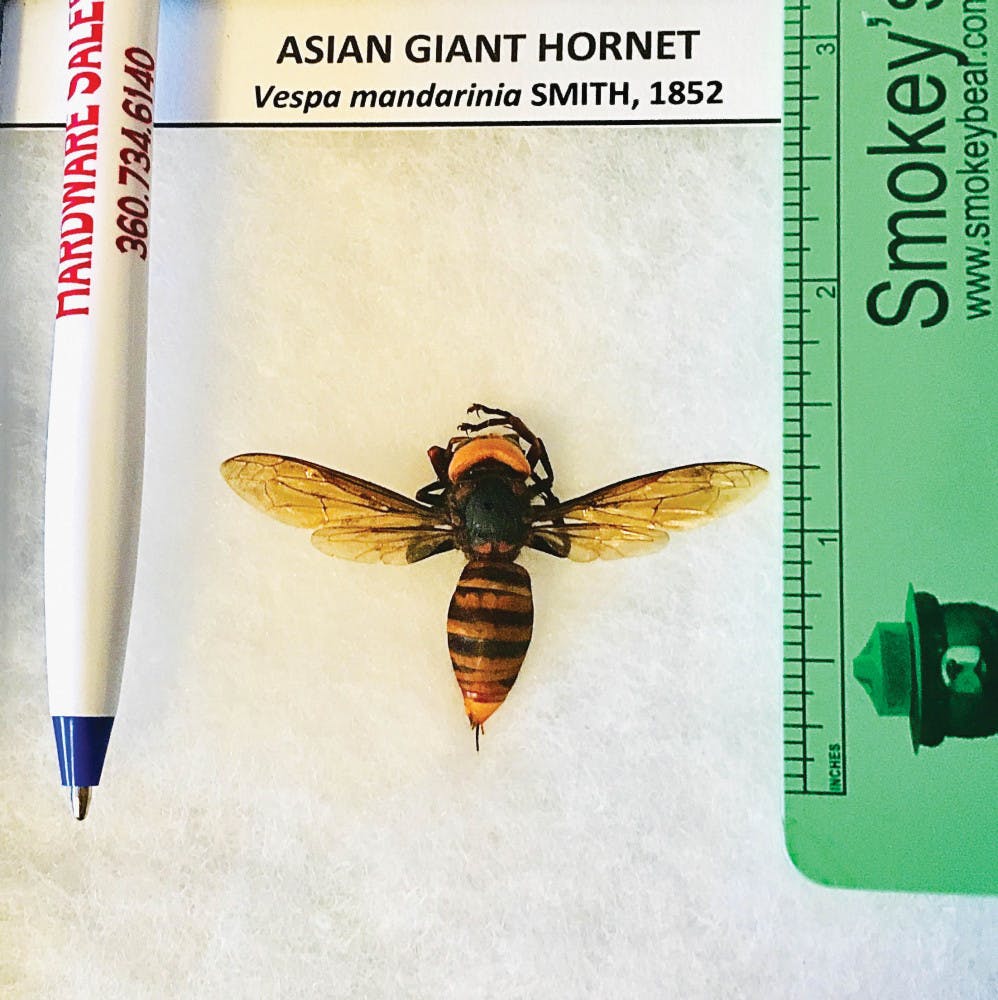State and federal authorities are scrambling to contain an invasion of the world’s largest species of hornet that threatens already vulnerable honeybee populations.
Three previously undisclosed incidents the Washington State Department of Agriculture believe mark the presence of the Asian giant hornet locally, and in the United States for the first time, make Whatcom County ground zero in a fight to stop the species from spreading into the U.S. and Canada.
Native to East Asia, the hornet was first reported in the U.S. this December near Blaine. A dead specimen allowed the state department of agriculture to confirm it was actually the oft-misidentified hornet.
The hornets, described by British Columbia provincial apiculturist Paul van Westendorp as “the apex predator of the insect world,” feed on honeybee hives, quickly devastating them.
Following media coverage and outreach, the state department of agriculture has identified three incidents—two near Blaine, one near Bellingham—that predate the December sighting. The British Columbia Ministry of Agriculture has also identified a sighting in the border city of White Rock, as well as a nest on Vancouver Island which was destroyed in September.
Teddy McFall discovered one of his bee hives located about three miles from the Blaine sighting had been massacred in October. Piles of thousands of decapitated bees lay outside what had been an otherwise healthy hive.
“It was kind of like someone took scissors and went through and cut up all the bees,” McFall said.
While not all reports can be verified for certain, van Westendorp says the reports’ distribution beyond the usual five-mile foraging range of the hornets may indicate there are multiple nests in the border region.
The presence of a nest in December is concerning because nests usually collapse in fall while queens disperse to spend the winter alone and establish new nests in the spring.
“If a nest can survive over the course of the winter season, it has a huge head start in the coming spring,” van Westendorp said.
This pits authorities, only alerted to the bug’s U.S. presence a month ago by the Blaine report, against a ticking clock as they prepare for increased activity in the spring and summer, and seek to prevent the pests from establishing a foothold in the U.S. and Canada.
Karla Salp, a spokesperson for the state department of agriculture, emphasized that response efforts were still in initial stages. A Jan. 2 conference call with state, federal and Canadian authorities involved conversations about who was in charge of the response, and funding still needs to be determined as budget requests to the legislature were due in the fall.
“We don’t have an Asian giant hornet fund,” Salp said.
Key to initial efforts is identifying the locations of the nests, and Salp said they plan to appeal to the public for help. The state department of agriculture, which is heading up U.S. efforts, plans to release an advisory this week asking the public to provide more information and has set up a form to facilitate reports.
They plan to deploy traps in the spring when queens start to emerge and then step up the intensity of the efforts in the second half of summer, Salp said, noting that the scope of efforts and methods are still being determined.
While the hornets nest underground, which makes finding their exact location tricky, according to van Westendorp, they can generally be identified by their large size and yellow heads.
Joe Boggs, an assistant professor at Ohio State University Extension who specializes in non-native insect pests, said that the bug’s predilection for honeybees may work against it.
“[In dealing with pests], the holy grail is some kind of attractant that brings them in,” Boggs said.
For this reason, officials on both sides of the border are counting on local beekeepers to help them identify the threat, with the state department of agriculture sending notice to some 1,500 beekeepers.
However, this also makes the hornets a threat to beleaguered honeybees that local beekeepers say have faced attacks from mites in recent years and are crucial to agriculture. The forthcoming state release notes that a similar form of hornet introduced in Europe resulted in a two-thirds decrease in honey yield.
While van Westendorp cautions there are crucial differences—those hornets are smaller, much more numerous and use different tactics—Salp said they’re worried about the impact not just on local beekeepers, but industries that rely on them.
“This is a really bad pest for honeybees and they have enough to worry about,” she said.
Washington agricultural authorities urge people to forward suspected sightings, preferably with photos, to PestProgram@agr.wa.gov. Caution should be exercised: Asian giant hornet stings are generally not more dangerous than normal hornet stings, but there have been a number of fatalities in Asia from disturbed hives, van Westendorp said.
In the meantime, members of the Mt. Baker Beekeepers Association are seeking to spread the word about the hornets. Co-president Daryl Hill said he’s bracing for summer.
“That’s the question mark,” Hill said. “Now what the hell are they going to do?”
This story was edited after publication to clarify the role of the Washington State Department of Agriculture.






